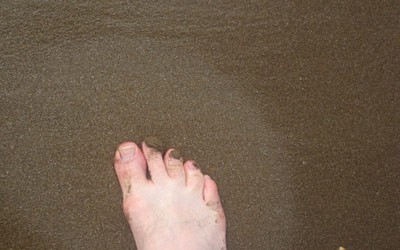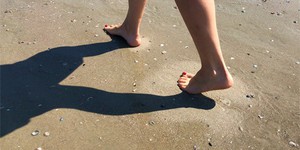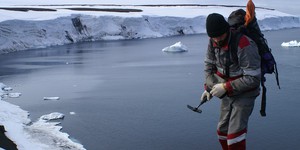Explore the Wet Sand Effect
Summary
Introduction
Summer is the perfect time to take a stroll at the beach and walk barefoot along the shoreline. While doing that, have you ever looked at your footprints in the wet sand? If so, you might have noticed that with every step it looks like the sand around your feet dries out. Why is that? These dry footprints are caused by the pressure of your feet. You will find out exactly how this happens by doing this beachy activity!
Materials
- Bowl
- Sand
- Water bottle (narrow mouth)
- Large balloons (2), ideally transparent or translucent
- Transparent straws (2)
- Rubber bands (2)
- Paper
- Spoon
- Water
- Optional: wide-mouthed plastic water bottle
- Optional: ruler
- Optional: tape
- Optional: permanent marker
- Optional: c-clamp
- Optional: scrap wood pieces (2)
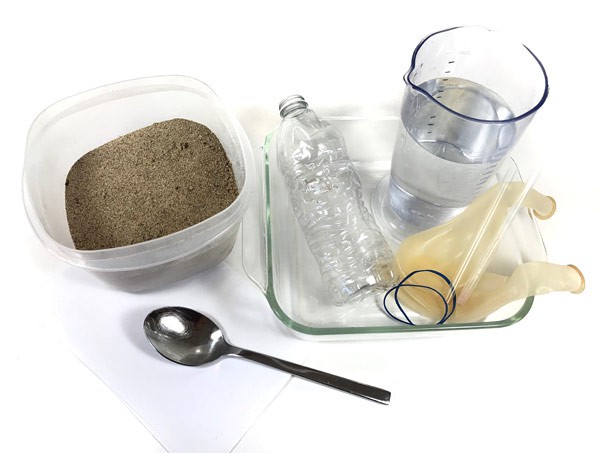 Image Credit: Sabine De Brabandere, Science Buddies / Science Buddies
Image Credit: Sabine De Brabandere, Science Buddies / Science Buddies
Prep Work
- Fill the water bottle all the way up with dry sand. Use the paper to make a funnel and place the funnel into the mouth of the bottle. Then spoon the sand into the paper funnel.
- Inflate one of the balloons. Then stretch the balloon's neck over the mouth of the water bottle. Flip the bottle upside-down and pour the sand into the balloon.
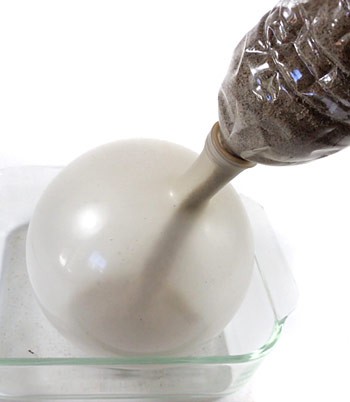 Image Credit: Sabine De Brabandere, Science Buddies / Science Buddies
Image Credit: Sabine De Brabandere, Science Buddies / Science Buddies
- Once all the sand is in the balloon, remove the balloon from the bottle and let the remaining air out. The balloon should now be filled with sand only.
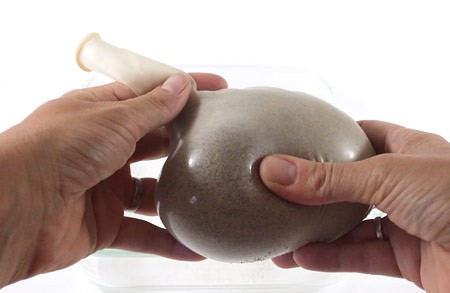 Image Credit: Sabine De Brabandere, Science Buddies / Science Buddies
Image Credit: Sabine De Brabandere, Science Buddies / Science Buddies
- Add water to the sand inside the balloon until the sand is saturated and cannot absorb any more water. The sand should look darker from all sides once it is saturated with water.Where does the water go when you pour it on the sand?
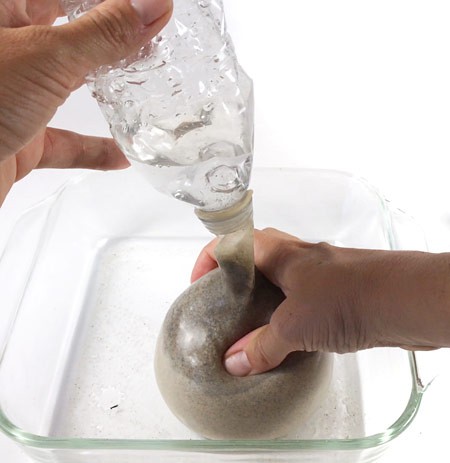 Image Credit: Sabine De Brabandere, Science Buddies / Science Buddies
Image Credit: Sabine De Brabandere, Science Buddies / Science Buddies
- When the sand is saturated, insert a straw far enough into the neck of the balloon so that the end of the straw is in the wet sand. Attach the straw tightly in place with a rubber band around the neck of the balloon. It does not matter if there is some water inside the straw at this point.
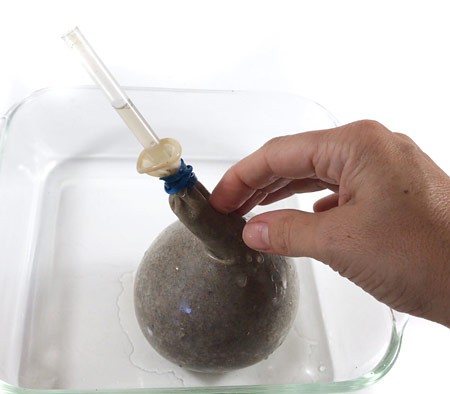 Image Credit: Sabine De Brabandere, Science Buddies / Science Buddies
Image Credit: Sabine De Brabandere, Science Buddies / Science Buddies
- Fill the second balloon with water (no need to inflate this one). Then insert the second straw into the neck of the balloon so that the end of the straw is in the water. Again, attach the straw tightly with a rubber band.
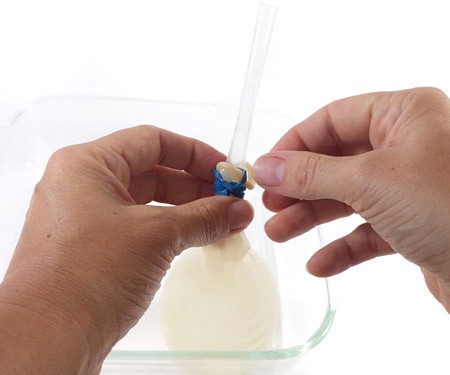 Image Credit: Sabine De Brabandere, Science Buddies / Science Buddies
Image Credit: Sabine De Brabandere, Science Buddies / Science Buddies
Instructions
- Hold the balloon filled with water at its neck where it is connected to the straw. Keep it on top of a bowl in case of water spills. Then add water to the straw until it is filled up half way.What do you think will happen to the water in the straw when you squeeze the balloon?
- Squeeze the balloon slightly with your hands. Observe the water inside the straw.What happens to the water inside the straw? Did you expect this to happen?
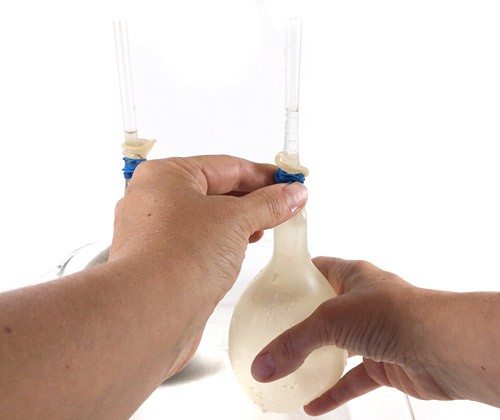 Image Credit: Sabine De Brabandere, Science Buddies / Science Buddies
Image Credit: Sabine De Brabandere, Science Buddies / Science Buddies
- Put the water-filled balloon aside and take the sand-filled balloon. Again, add water to the straw until it is filled up half way.What do you expect to happen this time when you squeeze the balloon?
- With both hands, squeeze the balloon as much as you can. Observe what happens to the water inside the straw while you compress the saturated sand.Does the water level in the straw rise, fall, or stay the same? Can you explain your observations?
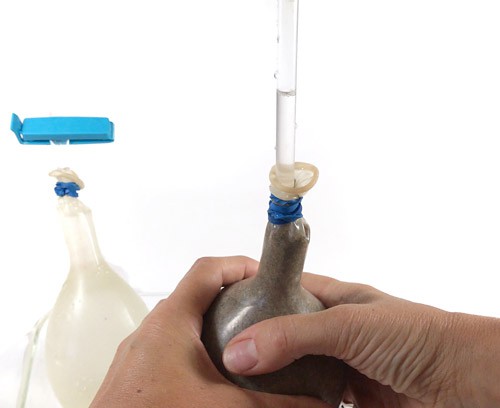 Image Credit: Sabine De Brabandere, Science Buddies / Science Buddies
Image Credit: Sabine De Brabandere, Science Buddies / Science Buddies
- Finally, release the pressure on the balloon and shake it slightly while observing the water level in the straw.Does the water level change again? How?
Cleanup
What Happened?
Did you see the water disappear into the sand-filled balloon? You should have! When you squeezed the water-filled balloon, you probably saw water rise up the straw, as you expected. However, when you squeezed the sand-filled balloon, the water level went down, which seems counterintuitive. This happens because under pressure the sand particles pushed each other farther apart, making the sand expand in volume. This creates more space between the sand particles, which the water inside the straw can drain into.
When you release the pressure on the sand and shake the balloon a little bit, the sand particles go back into their previous, denser arrangement. As a result, the water inside the straw starts to slowly rise again as the pore space between the sand particles decreases. This is exactly what happens when you make a dry footprint on wet sand. As your foot applies pressure to the saturated sand underneath, the grains of sand move which creates more pore space for the water to disappear in. The sand around your foot appears dry. When you remove your foot and the pressure on the sand, the water comes back out of the sand.
Digging Deeper
Many beaches are made of sand—rocks that have been ground into tiny particles by the forces of wind and waves. Materials that are made of many separate tiny particles are called granular materials. Even when sand particles appear to be directly touching each other, since they are irregularly shaped, there are tiny spaces in between them. These spaces are called pores. There are many pores in between all the sand particles at the beach.
If you pour water on the sand, the water seems to disappear into the sand. It doesn't actually disappear, but it drains into the tiny pores between the grains. Once all these pores are filled with water, the sand is saturated, which means that the sand cannot take up any more water. When you squeeze this saturated sand, you would probably expect the water in the sand to come out of the pores again, similar to what happens when you squeeze a wet sponge. However, this is not what happens. The exact opposite is the case. More water seems to disappear into the sand! The reason for this is something called dilatancy of granular materials.
Dilatancy means that a material expands when you squeeze it (put it under pressure) instead of contracting. This happens because under pressure, the already compacted sand grains push each other slightly farther apart, which makes more space between them. This makes more space for water to flow into, resulting in a dry footprint on the beach! Once the pressure is released, the sand grains settle closer together again, leaving less room for water.
Ask an Expert
For Further Exploration
- Try a simpler version of this experiment. Add sand to a wide-mouthed plastic water bottle until it is three quarters full. Add water until the sand is saturated and you have about a quarter inch of water standing on top of the sand. Then squeeze the water bottle with your hands. What do you notice? While squeezing, turn the water bottle upside down over a bowl. Do you see water dripping into the bowl when inverting the bottle? Then stop squeezing the bottle and shake it slightly. What happens? Finally, turn the water bottle upside down without squeezing it. Does water get into the bowl this time?
- What other granular materials can you use to demonstrate the wet sand effect? Try clay, glass stones, or magic sand. Do you get similar results?
- Try to quantify how much water disappears into the sand depending on the pressure you apply to the balloon. Hold a ruler next to the straw and make marks every quarter inch with a permanent marker. Then instead of using your hands to apply pressure to the balloon, use a C-clamp that you wrap around the middle of the balloon. To apply pressure to a larger area of the balloon, you can put a scrap wood pieces on each side of the balloon before you attach the C-clamp. Write down how much the water level changes with every turn of the C-clamp screw.


